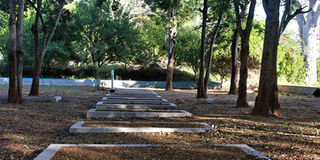Kibwezi graveyard marks where PCEA first started

A graveside at Kibwezi PCEA church. Members of a band of largely Scottish missionaries who arrived in Kibwezi in 1891 are buried there. PHOTO | PIUS MAUNDU | NATION MEDIA GROUP
What you need to know:
- It is where members of a band of largely Scottish missionaries who arrived in Kibwezi on October 16, 1891 are buried.
- The Kibwezi graveyard stands defiantly as an indelible show of missionaries’ struggles and locals’ reluctance to adopt modern culture.
Travelling to Kibwezi township for the first time one is likely to overlook the historically significant PCEA church, tucked in a wooded corner of the busy town in Makueni County.
This is because there are no iconic monuments announcing the idyllic address where the Presbyterian Church started.
A graveyard with 11 neatly arranged graves — 10 of them unmarked — sits in one corner of the sprawling church compound, which extends into Kibwezi Forest.
This is where members of a band of largely Scottish missionaries who arrived in Kibwezi on October 16, 1891 are buried.
A signage installed at the entrance of the graveyard 100 years later identifies the fallen missionaries as James Stewart (mission leader), George Wilson (safari leader), Thomas Watson (preacher), John Greig (engineer), Cornelius Rahman (storekeeper), John Linton (carpenter) and a Dr Moffat.
TOURISTS
The grave for Ronald MacDougal, who died on March 4, 1898 aged 24 years, has a tombstone that was installed much later by his father John MacDougal of Ensay, Scotland.
“Owing to the infestation of Kibwezi by malaria and the subsequent loss of life of missionaries, Mr Thomas Watson visited Dagoretti to explore possibilities of transferring the mission station.
The missionaries moved from Kibwezi to Dagoretti in 1898 where they constituted themselves as the "Church of Scotland Mission (CMS)”, reads part of the church’s history published on its website.
With its headquarters in Nairobi, the church, traces its roots to Kibwezi. It set up a modern church building next to the abandoned graveyards in 1979 and took over the management of the graveyard from neighbouring Dwa Sisal Estate, which has been managing it for decades.
The church also runs a nursery school, a dispensary and a vocational training college at the Kibwezi station.
Tourists are not charged to visit the graveyard whose entrance has signage on identities of the seven missionaries.
MISSION
The missionaries were part of a larger team of ambitious Imperial British East Africa merchants who were juggling the company’s mission: to explore investment opportunities in the rich countryside and evangelism.
They followed trails set by ivory and slave traders, which led them to the enchanting source of River Kibwezi on whose banks they settled.
Their presence brought tension in Kibwezi, according to 89-year-old John Kyalo, an author and local village administrator, who is also a retired schoolteacher and former policeman.
CURSE
Powerful and revered colonial-era chief Kilundo Meli allegedly cursed the missionaries after falling out with them. “Kikumbulyu chief Kilundo Meli cursed the missionaries after they ate three of his sheep and laughed at his appeal for compensation,” writes Kyalo in one of his manuscripts in which he traces the history of the Ngulya people, a Kamba sub-tribe, between 1800 and 2000.
The Kibwezi graveyard stands defiantly as an indelible show of missionaries’ struggles and locals’ reluctance to adopt modern culture.
Only two pupils enrolled at a school the missionaries started.
The unfortunate series of events accentuate claims that the missionaries succumbed to Mr Meli’s curse as advanced by local folklore.





